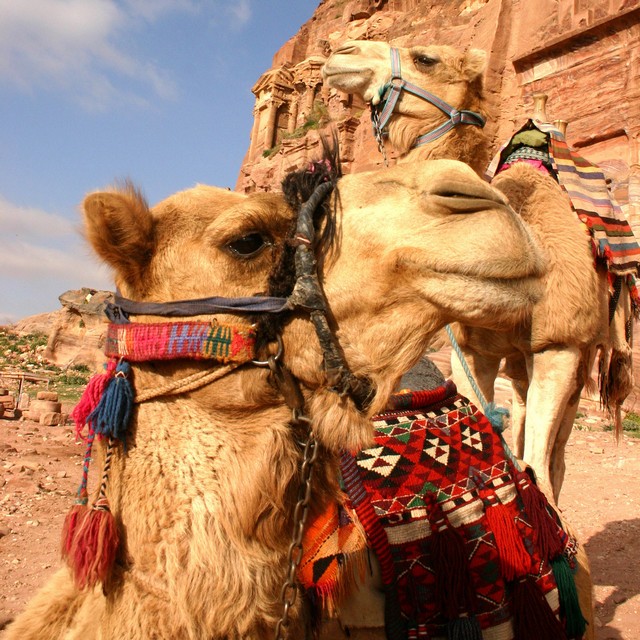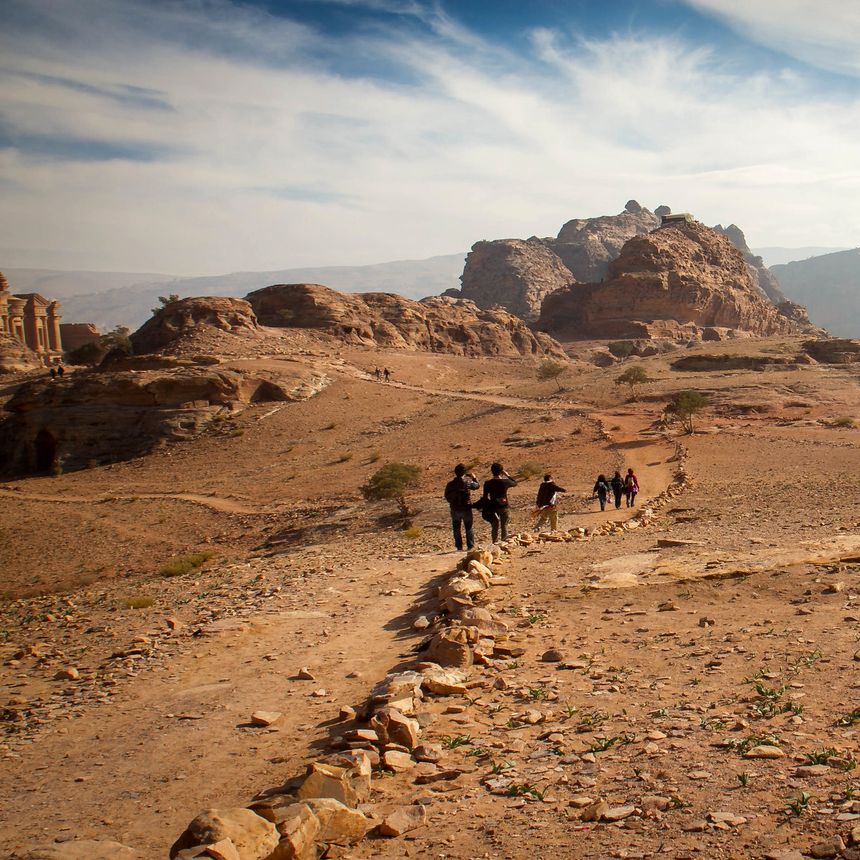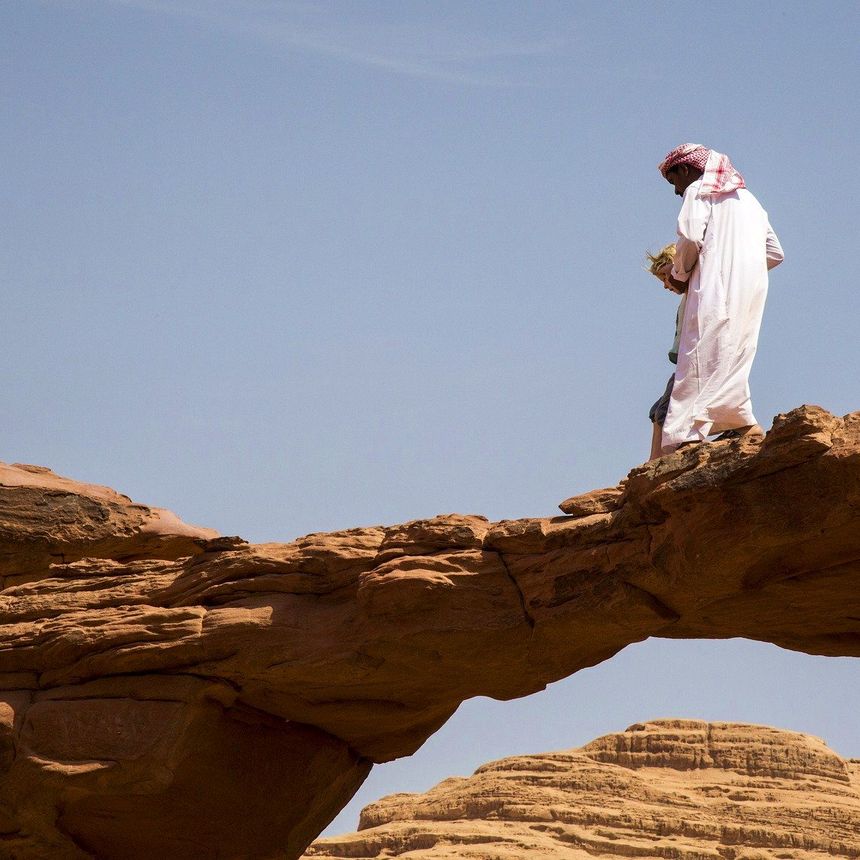
Day 1 : Amman
Arrive into Amman. You will be met by a Travel The Unknown representative and transferred to your hotel. Overnight in a comfortable hotel in Amman.
Meal plan: n/a
Explore the magical Land of the Bedouins through some of its most remote and stunning trails. Explore the stunning Ajloun Reserve and its spectacular castle. Discover the incredible mosaics of Madaba, the beautiful Mount Nebo, where Moses was exiled, and Karak's imposing Crusader castle. Finally hike from the incredible Dana Biosphere Reserve, a unique eco-project, to the world famous UNESCO site of Petra.
Read about Diana Darke`s experiences on this trip (on the Financial Times website).
Amman - Ajloun - Pella - Mount Nebo - Madaba - Feynan - Crusader’s Castle of Kerak - Dana Biosphere Reserve - Little Petra - Petra - Wadi Musa

Arrive into Amman. You will be met by a Travel The Unknown representative and transferred to your hotel. Overnight in a comfortable hotel in Amman.
Meal plan: n/a

After breakfast we will be transferred to Ajloun. We will hike along the Al Oyoun trail. The trail starts from a mountain overlooking Rasoun village. We will be hiking through the woods, passing ruins of ancient and primitive wineries, in addition to the remains of old dolmans. Pass oak, fig, cherry and pomegranate trees as well as fields of what locals call Roman Olive trees. Descend and pass through a village where we will stop by the Calligraphy House where a presentation will be made by local women about the different kinds of Arabic Calligraphy. The next stop is the Soap House where we will learn about making soap from olive oil and local plants. Before we continue our hike we will pay a visit to one of the simple homes in the village where a local family will be our host and serve us lunch.
After lunch we continue our walk on a small road along Wadi Orjan passing local farms. Our trail ends at an old water mill dating back to the 16th Century. If we are lucky we may see it in action, and have a cup of tea by the mill. A short vehicle transfer then takes us up to Ajloun where the main attraction is the stronghold of Qala'at al-Rabadh, a fine example of medieval Arab/Islamic military architecture. The castle was built between 1184-85 by the nephew of Salah Addin al-Ayyubi (known in the West as Saladin). We tour the castle and enjoy the spectacular views before we go to the home of one of the local families who will host us at their simple home, share a nice dinner of delicious local food and spend the night. Today's lunch, dinner and overnight experiences that are hosted by members of the village communities are a great opportunity for some local interaction and an insight into the culture and life-style of the villages of the less-travelled northern part of Jordan. This is also part of our responsible travel initiative to support the local communities at the places we visit. Home stay at Baoun.
Walking distance is 12-13 km, starting altitude approx 800m, walk ends at approx. 550m. (250m descent, 100m ascent), duration: 5-6 hours.
Meal plan: Breakfast, lunch & dinner

After breakfast we'll say goodbye to our local host family and transfer to Beit Idis to commence our second trek. We'll start walking west from Beit Idis along a lane for 300m to where an oak stands above tombs cut in limestone. Right next to these tombs, we'll stop by a cave where Jesus is believed to have stayed before being baptized in the Jordan river. We then proceed towards Pella through Wadi Salih. This trail is a delightful descent through unexpected pine forests and pretty valleys amongst rolling hills following a fairly well-used path alongside the streambed of Wadi Salih leading down to the foot of Jebel Sartaba (Sartaba hill). An easy ascent takes us to its summit for some superb views in all directions, particularly west across the Jordan Valley to the hils of Gilbao in Palestine. We then descend to Wadi Jirm and climb up to Pella at sea level for a chance to explore the remains of this ancient Roman city and have a little rest before we transfer to Madaba. Overnight in a hotel in Madaba.
Meal plan: Breakfast, lunch & dinner

After breakfast we will take a tour of Madaba visiting the Church of St. George in the middle of town. We will also visit the church of apostles and the Archeological Museum. Then we head to Mount Nebo, known as Pisgah in the Bible. According to the Bible this is where Moses lived out his remaining days. We then head to Kerak which lies on the ancient caravan routes that used to connect Egypt to Syria and its commanding position almost 1000 meters above the Dead Sea Valley made it a strategic asset of great importance. After we finish our tour in Kerak we will head to Feynan - at the desert zone of Dana Biosphere Reserve - to spend the night. Overnight in an Ecolodge.
Meal plan: Breakfast & dinner

Leaving the serenity of Feynan Ecolodge at around 300m, we start our trek to Petra heading southward along the flat undulating stony desert of Wadi Araba. Walking through Feynan village we visit some of the oldest archaeological ruins on earth, all related to the largest copper mines in antiquity, going back more than 5000 years ago! Our trek takes us further south with spectacular views of the high mountain ranges to the east and the vast Wadi Araba Desert to the West where the desert becomes more and more remote with little signs of human activity. Some Acacia trees scattered in the area provide a little shade for lunch and a rest. A couple of hours walk later we reach our camping location at the outlet of Wadi Barwas where we find our crew has set up our camp. Wadi Barwas provides a nice little gorge with seasonal water, a good place for a shower!
Meal plan: Breakfast, lunch & dinner

This morning we spend two hours walking around the foot of the mountain (along the western side of the Sharah mountains) to reach the trail head of a Bedouin migration path. Walking where the Bedouin once travelled on their nomadic journey we head up along a shaded gully full of centuries old Juniper trees. There are breathtaking vistas of the Wadi Araba desert below, and sand dunes on the horizon! Once you reach the top of the gully we can see lush greenery down below. Snaking its way around the mountains opposite you can make out the following day's trail; you will be impressed by the never-ending change of scenery! We break for lunch at a spring with a chance to wash up and refresh using very welcome cold spring water. After lunch we walk up the Wadi (meaning \"valley\" in Arabic), along an ancient aqueduct overlooking thick dense vegetation in the Wadi below. The birds singing and trees swaying make this feel like a tropical paradise! After walking up a mostly dry Wadi bed through a colourful gorge, we arrive at our camp for the night. Again, the crew will be waiting for us with a warm hearty dinner and our campsite all set up.
Meal plan: Breakfast, lunch & dinner

Today is the most scenic day of the hike, but you have to work hard for some astonishing views of Jordan. It is your chance to see the elusive Ibex if you tread lightly and keep your eyes peeled! Contouring the Sharah Mountains, today we follow a trail of mostly clear Bedouin shepherd trails. On the remotest sections of the trail we are on less trodden (and hence harder to identify) hunters paths. The sheer peaks of black mountains overlooking our trail and steep precipitous drops of the canyons below make this day absolutely spectacular! With lunch taken in the shade of a steep colourful sandstone overhang, overlooking the mountains in the distance and canyons below, we will find ourselves contemplating the sheer beauty of this stunning landscape. In the afternoon we take a long gentle uphill trail to the saddle of the famous 'conical hill' where you will be rewarded with another gorgeous view - worthy of the day's exertions! Relax and take it all in with another traditional hot dinner served by our crew and sleep under the stars (or in your tent - the choice is yours).
Meal plan: Breakfast, lunch & dinner

Just around the corner we enter yet another different landscape, with agricultural fields - farmed today by the local Bedouins as their ancestors, the Nabateans, did two thousand years ago. Up a juniper filled gully used by the locals for camel breeding, we are surrounded by eerie white sandstone domes looking at us with empty eye sockets! Our first glimpse of Petra will be Aaron's Tomb on the horizon overlooking the Nabatean capital Petra. We walk down to the campsite along one of the last remaining juniper forests in Jordan. But before we head to camp, we have the chance to visit one of the suburbs of Petra, called 'Little Petra', for a taste of what is to come the following day! At this small site we get a glimpse into ancient Nabatean trade and camel caravans. Then we head to our campsite which is owned by the Ammarin Bedouin Cooperative Society, a locally run campsite which benefits the Bedouin of the Ammarin tribe. Uniquely nested in a gully surrounded by sandstone mountains, the campsite provides us with the luxury of hot showers and electricity! Here we can charge our cameras for the big day ahead - walking into Petra!
Meal plan: Breakfast, lunch & dinner

Walking past some Bedouin encampments we are getting closer and closer to Petra, just around the Sharah Mountains overlooking Wadi Araba. You are reminded of the Great Rift Valley you have already walked but with even more majestic views all the way down to the desert of Wadi Araba where you started a few days ago! Today's path is a popular trail which gets us back to the reality that we are not the only people here, contrary to the solitude of the past few days. Turning around one corner and suddenly it reveals itself with all its beauty and grandeur, the Monastery of Petra (Ad-Deir), WOW! Definitely worth every drop of sweat! The rest of the day is spent exploring everything Petra has to offer, walking down from the Monastery you can see the Royal Tombs, Qasr el Bint, the Mountain Ridge Church, the Great Temple, Royal Tombs, Urn Tomb, the unique Theatre, the Street of Facades, and of course the famous Treasury. Today you will realize how unique a site Petra is, and why you have walked here rather than clambered from a bus.
Meal plan: Breakfast

Free day to either rest and relax in Wadi Musa or go down for another chance to further explore Petra at your leisure and satiate your curiosity. In the evening you will be transferred to Amman. Overnight in a hotel in Amman.
Meal plan: Breakfast

After breakfast transfer to Amman airport for onward flight.
Meal plan: Breakfast
Trek through Jordan's undiscovered trails
Discover the Red Sea's exhilarating range of water sports
Day trek ideas along the Jordan Trail.
Welcome to Jordan, the gateway to the Middle East
Walk the Land of the Bedouins
Discover Jordan's archaeological secrets
Special tour for Uncharted X clients
The highlights and history of Jordan
Nikki Kemp , Tailormade JordanThank you for organising our Jordan trip. We both had a fantastic time, everything went very smoothly,and this is the first time I have ever used an ‘organised trip’ but it made everything stress free and enjoyable. Very well organised. The driver Bashir, was absolutely brilliant - very friendly, kind,patient, and informative and really made the trip special and memorable for us and we learnt many things on route that would never have known if it wasn’t for local information. Thank you very much for your support for a wonderful trip!

Marie , Along Bedouin Trails, JordanWhat a great trip this was. Jordan is a magical county, the people friendly, the weather marvellous, the sights, sounds and smells unique. The small group got on well and I will definitely be back on one of your trips again soon.

David & Julia McPhail , Tailormade JordanJerash was fascinating, loved the mud at the Dead Sea, Bethany was very interesting. Petra by night... AMMMMMMMMMMMAAAAAAAAAZZZING, candle-lit all the way to the treasury with two musical instruments being played - the sound echoing around the city was truly mesmerizing, a wonderfully mystical experience. Fantastic guide too. Thanks for all your help.

Ian Shaw , Land of the Bedouins, JordanTravel The Unknown provided me with an excellent opportunity to discover the amazing country that is Jordan. Without their organisation and attention to detail I would have never have experienced so much diversity and interest in such a short time. Thanks so much.
